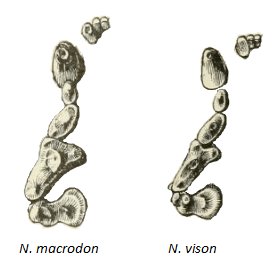Sea mink facts for kids
Quick facts for kids Sea minkTemporal range: Late Holocene
|
|
|---|---|
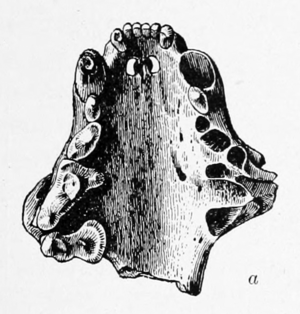 |
|
| Palatal aspect of the skull from the type specimen | |
| Conservation status | |
| Scientific classification | |
| Genus: |
Neovison
|
| Species: |
macrodon
|
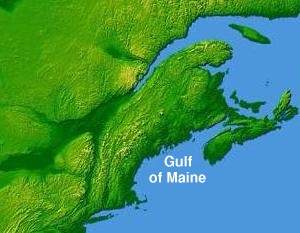 |
|
| The sea mink was found in the Gulf of Maine area. | |
| Synonyms | |
|
List
|
|
The sea mink (Neovison macrodon) was a type of mink that sadly disappeared not long ago. It lived along the eastern coast of North America, especially around the Gulf of Maine in New England. It was very similar to the American mink (Neovison vison).
Scientists still discuss if the sea mink was its own unique species or just a special kind of American mink. One big reason they think it was different was its size. The sea mink was much larger. It also had fur that was a bit redder. We only know about it from bone pieces found in old Native American trash piles, called shell middens. Its exact size is a guess, mostly from its teeth.
Scientists first described the sea mink in 1903, after it was already gone. We learn about what it looked like and how it lived from old stories by fur traders and Native Americans. It probably acted a lot like the American mink. This means it likely had its own territory and ate similar foods, but it focused more on seafood. The sea mink was the biggest of all minks. Because of its large size, fur traders wanted its fur a lot. This led to it becoming extinct in the late 1800s or early 1900s.
Contents
Discovering the Sea Mink
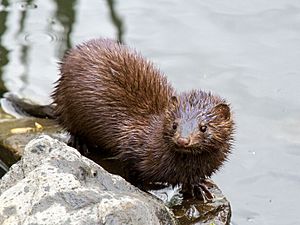
The sea mink was first described by a doctor and bird expert named wikisource:Author:Daniel Webster Prentiss. He named it Lutreola macrodon in 1903. This was after the animal had already become extinct. Prentiss based his description on skull pieces found in Native American shell middens in New England. Most sea mink remains, which are almost all skull fragments, have come from these shell middens. No complete sea mink skeleton has ever been found.
Scientists have debated if the sea mink was its own species or a subspecies of the American mink. Those who think it was a subspecies often call it Neovison vison macrodon. A study in 1911 by Frederic Brewster Loomis, a paleontologist, said the differences were too small for it to be a separate species. He called it Lutreola vison antiquus.
However, a study in 2000 by Mead and others disagreed with Loomis. They said the largest sea mink bones were bigger than any American mink bones. This suggested it was a separate species. But then, a 2001 study by Graham argued that this size difference wasn't enough proof. Graham thought the size difference might be due to where they lived. He also suggested that the smaller mink bones Mead studied might have been female sea minks, not American minks. A 2007 study looked at the teeth of both minks. It concluded that their teeth were different enough to make them two separate species.
| New World weasels | |||||||||||||||||||||||||||
|
|||||||||||||||||||||||||||
| Relations of the sea mink within Mustelinae |
In 2000, scientists changed how minks were classified. They created a new genus called Neovison. This group includes only the sea mink and the American mink. Before this, both minks were in the genus Mustela. The name macrodon means "large teeth." Some naturalists believe the sea mink's closest relative was a common mink found in New England.
Fur traders had many names for the sea mink. They called it water marten, red otter, and fisher cat. An early description might have come from Sir Humphrey Gilbert in the late 1500s. He called it "a fish like a greyhound" because it loved the sea and moved like a greyhound. The Abenaki Indians called it "mousebeysoo," meaning "wet thing." It was called "sea mink" because it was always found near the coast. The American mink was then often called the "wood mink."
Where the Sea Mink Lived
The sea mink was a marine mammal that lived along the rocky coasts of New England. It also lived in the southernmost Maritime Provinces of Canada. It was hunted until it became extinct in the late 1800s or early 1900s. Most sea mink remains are found on the coast of Maine.
People think they might have lived in Connecticut and Rhode Island at one time. They were often trapped along the coast of the Bay of Fundy. This area is part of the Gulf of Maine. There were also reports of very large mink furs from Nova Scotia.
Bones found in Middleborough, Massachusetts, were about 4,300 years old. This spot is about 19 kilometers (12 mi) from the ocean. The sea mink might have reached this area by traveling up rivers. Or, Native Americans might have carried the bones there. The second idea is more likely. No other mink remains have been found between Casco Bay in Maine and southeastern Massachusetts. Sea mink bones have been found in Canada too. But these might have been brought there by Native Americans from the Gulf of Maine.
The rugged coast of the Down East region of Maine might have been the northern edge of their home. Some scientists believe that sea minks only lived on islands off the coast. If this is true, then any bones found on the mainland were carried there. Others argue that it's unlikely all sea mink bones came from just one group of animals.
During the last glacial period, which ended 12,000 years ago, the sea mink's range might have gone further south. It might have even developed there. Maine would have been covered in glaciers at that time. However, the oldest known sea mink bone is only about 5,000 years old. This could be because rising sea levels have covered older remains. Or, the sea mink might have evolved after the glaciers melted. It could have filled a new role in the environment.
What the Sea Mink Looked Like
We only have bone pieces of the sea mink. So, we don't know exactly what it looked like or how it behaved. We can guess based on its relatives and stories from fur traders and Native Americans. Native Americans said the sea mink had a fatter body than the American mink. It also had a strong fishy smell. Its fur was said to be rougher and redder than the American mink's fur.
A naturalist named Joseph Banks might have seen this animal in 1776. He described it as a bit bigger than a fox. He said it had long legs and a tail that got thinner at the end, like a greyhound.
The sea mink was the largest of all minks. Since we only have bone pieces, its size is mostly guessed from its teeth. In 1929, wildlife artist Ernest Thompson Seton thought it was about 91.4 centimeters (36 in) long from head to tail. Its tail was about 25.4 centimeters (10 in) long. A possible sea mink specimen from 1894 was 72 centimeters (28 in) long with a 25.4 centimeters (10 in) tail. But a 1996 study suggested this might have been a large American mink or a mix of two species. This specimen had rough, reddish-tan fur, likely faded with age. It was darkest on its tail and back legs. It also had a white patch between its front legs.
The first sea mink specimen used for scientific description was found in 1897. It included parts of the upper jaw, nose bone, and palate. Its teeth were in good shape. This specimen was larger than the Alaskan mink. The Alaskan mink is the largest living American mink subspecies. The sea mink's skull was clearly bigger than other minks. It had a wide snout, large nose openings, and big teeth. Its large size probably helped it live in its coastal home. The largest living American mink also lives in a similar coastal area.
Male sea minks were likely bigger than females. This is common in animals like weasels. The sea mink's wider and blunter teeth suggest they often crushed hard shells.
Sea Mink Behavior
Sea minks were important hunters in their coastal environment. They probably ate a similar diet to American minks. This included seabirds, seabird eggs, and hard-shelled sea animals. Fur traders said sea mink dens had two entrances. They were made in rocks piled up by waves. Bones of fish like toad sculpins and ocean pouts were common around their dens. Snails were also part of their diet. Eating a lot of seafood might have helped them grow so large. Fur traders also said sea minks were nocturnal. This means they were active at night. They would hide in caves and rock cracks during the day.
It's possible that American minks and sea minks sometimes had babies together. Even though sea minks stayed near the coast, they were very good in the water. They were one of the most aquatic members of their family, besides otters.
Like other minks, individual sea minks probably had their own territories. Males were bigger and needed more food, so they likely had larger territories. Their bigger size might have also allowed males to hunt larger prey than females. They might have also protected females during mating season. Like other weasels, sea minks probably mated with multiple partners.
Why the Sea Mink Disappeared
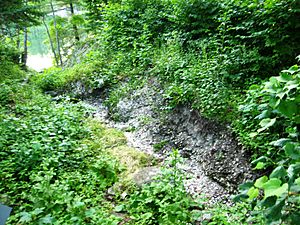
Fur traders hunted the sea mink because of its large size. This made its fur more valuable than other mink species found inland. The uncontrolled fur trade eventually led to its extinction. Scientists believe this happened between 1860 and 1920. The sea mink was rarely seen after 1860.
The last two reported sea mink killings were in Maine in 1880 near Jonesport, Maine. Another was on Campobello Island, New Brunswick, in 1894. However, the 1894 killing might have been of very large American minks. Fur traders used traps to catch sea minks. They also hunted them with dogs. If a sea mink escaped into a small hole in the rocks, hunters would dig it out. They used shovels and crowbars. If it was too far to reach, they would shoot it. Then they would get it with an iron rod that had a screw on the end. If it was hiding, they would smoke it out until it couldn't breathe. The minks' habit of being active at night might have started because fur traders hunted them during the day.
Bones of sea minks found in shell middens are often broken. Many show cut marks. This suggests that Native Americans hunted sea minks for food. They might have also used them for trading or for special ceremonies. One study found that sea mink skulls in Penobscot Bay were often whole. This was more common than with other animal bones found there. This might mean they were placed there on purpose. More male sea minks were found than females.
See also
 In Spanish: Visón marino para niños
In Spanish: Visón marino para niños



